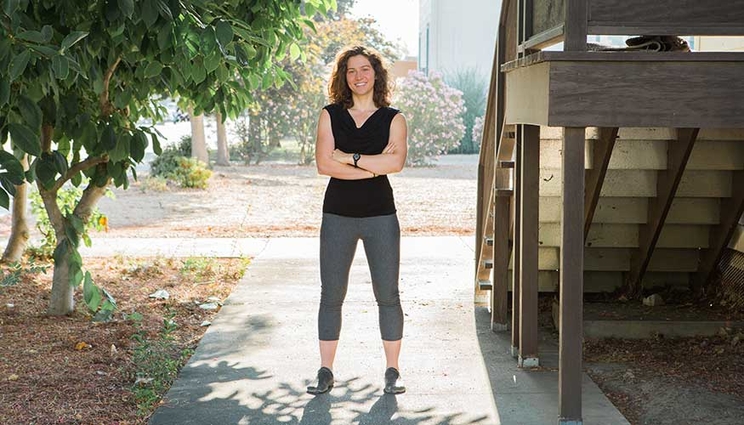Lab fellowship enriches intern's bucket list
 (Download Image)
Jane Herriman is one of 19 interns completing fellowships at Lawrence Livermore’s Computational Chemistry and Materials Science Summer Institute.
(Download Image)
Jane Herriman is one of 19 interns completing fellowships at Lawrence Livermore’s Computational Chemistry and Materials Science Summer Institute.
Michigan native Jane Herriman is one of 19 interns completing fellowships at Lawrence Livermore’s Computational Chemistry and Materials Science (CCMS) Summer Institute. The 10-week program matches graduate students to scientists who mentor them and offers courses and twice-weekly lectures to round out the experience. For more than 15 years, the CCMS Summer Institute has given interns the opportunity to explore topics as diverse as quantum mechanics, fluid dynamics and phase-field modeling.
Herriman’s path to the Laboratory was more circuitous than straight. "I always felt like an edge case," she says of her academic interests. Math snared her attention first, followed by chemistry and physics as she learned to apply math to real-world problems. Encouraged by high school teachers, Herriman pursued science in college. She majored in chemistry and French at Carnegie Mellon University and discovered materials science during a Dow Corning internship. Through a subsequent Fulbright grant, Herriman went to Switzerland to study semiconducting nanowires for solar-cell applications. From that point she decided to switch to materials physics for graduate school.
Now, midway through a Ph.D. program at the California Institute of Technology, Herriman is shifting focus again. Her graduate work in computational materials physics explores the thermodynamics of semiconducting systems. Outside of that curriculum, Herriman took up computer science because the logic appealed to her. "I find it really beautiful and really clean," she says of coding, which she taught herself on top of her regular course load. Herriman’s pivot to high-performance computing has taken root at Lawrence Livermore.
Where Computation Meets Physics
Qb@ll, the Laboratory’s version of Qbox code, is a first-principles molecular dynamics code that uses density functional theory to account for quantum mechanical effects in simulations of molecules and solid-state systems. By producing large amounts of information quickly, computer programs like Qb@ll help scientists investigate a material’s mechanical properties — electrical conductivity, for example — before conducting experiments. This computational modeling can be used to complement or reduce laboratory work, such as identifying candidate materials for experiments or reproducing extreme conditions more easily. Safer, more efficient experiments support scientific advances within LLNL’s national security mission. Under the direction of scientists Erik Draeger and Xavier Andrade, Qb@ll has achieved significant scalability, allowing it to take advantage of today’s parallel architectures and to model larger systems.
Mentored by Draeger and Andrade, Herriman enabled Qb@ll to perform simulations more rapidly. Although initially Herriman lacked experience with large-scale parallel software, Andrade watched her progress quickly. Her programming aptitude helped focus their discussions on ideas and algorithms. "Jane is quite good at realizing the important details," Andrade says. "She can now implement on her own without needing any guidance with the code."
Herriman values this experience at the Laboratory. "People are generous with their time," she notes, describing opportunities to learn about computational science methods and research at a national laboratory. After many years of student life, she has enjoyed the collaborative atmosphere at LLNL. For the first time, Herriman has been able to participate in an open-source project — an item on her bucket list.
Never Too Late
Herriman remembers feeling as a young student "like I wasn’t smart enough for physics." Now she knows better. "Using math to solve puzzles" has driven her to seek the right opportunities for her desired career path. Interested in professions outside academia, Herriman found the CCMS program through a Google search. She observes, "It can be hard for women to feel confident" in a traditionally male-dominated field, and recommends that students considering the summer institute reach out to LLNL scientists with similar interests. Both Draeger and Andrade supported her application after she contacted them.
As summer comes to a close, Herriman wants to continue programming Qb@ll and tie it into her Ph.D. work. Ultimately she would like to work at a national laboratory where she can make use of her science-meets-coding background. Before coming to LLNL, she had been studying properties of certain materials; now she develops tools for others to do so. The CCMS Summer Institute gave Herriman the means toward an end. As the chemist-turned-physicist-turned-programmer summarizes, "It’s never too late to change your trajectory."
- Holly Auten
Contact
 Anne M. Stark
Anne M. Stark
[email protected]
(925) 422-9799
Related Links
Computational Chemistry and Materials Science Summer InstituteTags
HPC, Simulation, and Data ScienceHPC
Featured Articles







